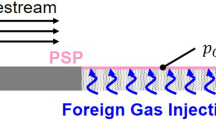Abstract
Recently optical pressure measurement systems using pressure sensitive paints (PSP) have actively developed to measure continuous pressure distributions on solid surfaces. However, the pressure range has been almost limited above 130 Pa (about 1 Torr) and there is no application to lower pressure range because the pressure sensitivity seems to be not so high in that range. In this study, we have applied three types of PSP [two types are composed by organic dye and polymer (luminophore/binder); PtOEP/GP197 and PtTFPP/poly(TMSP), and another one is Bath-Ru adsorbed on anodized aluminum] to the rarefied gas flow mainly lower than 130 Pa and examine those fundamental properties such as pressure sensitivity, leading to selection of the most suitable PSP among them for the low-pressure range. Since PtTFPP/poly(TMSP) has the highest sensitivity, it is applied successfully to the measurement of the two-dimensional pressure distribution on the surface interacting with a low density supersonic free jet.
Similar content being viewed by others
References
Asai, K., Amao, Y., Iijima, Y., Okura, I. and Nishida, H., Novel Pressure-sensitive Paint for Cryogenic and Unsteady Wind-tunnel Testing, J. of Thermophysics and Heat Transfer, 16-1 (2002), 109–115.
Asai, K., Kanda, H., Cunningham, C., Erausquin, R. and Sullivan, J. P., Surface Pressure Measurement in a Cryogenic Wind Tunnel by using Luminescent Coating, ICIASF ’97 Record, (1997), 105–114.
Egami, Y., Iijima, Y. and Asai, K., Optimization of Polymer-based PSP for Cryogenic Wind Tunnels, ICIASF 2001, (2001), 177–185, IEEE.
Engler, R. H., Hartmann, K., Troyanovski, I. and Vollan, A., Description and Assessment of a New Optical Pressure Measurement System (OPMS) Demonstrated in the High Speed Wind Tunnel of DLR in Göttingen, DLR-FB (1991).
Fujimoto, T., Sato, K., Naniwa, S., Inoue, T., Nakashima, K. and Niimi, T., Visualization of Impinging Supersonic Free Jet on a Tilt Plate by LIF and PSP, J. of Visualization, 4-2 (2001), 151–158.
Kavandi, J., Callis, J., Gouterman, M., Khalil, G., Wright, D., Green, E., Burns, D. and McLachlan, B., Luminescent Barometry in Wind Tunnels, Rev. Sci. Instrum., 61-11 (1990), 3340–3347.
Liu, T., Campbell, B. T., Burns, S. P. and Sullivan, J. P., Temperature- and Pressure-sensitive Luminescent Paints in Aerodynamics, Appl. Mech. Rev., 50-4 (1997), 227–246.
Nakagawa, T., Gas Permeability of Poly [1-(trimethylsilyl)-1-propyne] Membrane, MEMBRANE, 20-3 (1995), 156–168, in Japanese.
Sakaue, H., Sullivan, J. P., Egami, Y., Iijima, Y., Asai, K., Engler, R. H., Beifuss, U. and Döring, F., Open-system Pressure Sensitive Paint for Surface Pressure Measurements in a Cryogenic Wind Tunnel, ICIASF 2001, 186–195, IEEE (2001).
Author information
Authors and Affiliations
Corresponding author
Additional information
Hideo Mori: He received his M.S. degree in Electronic-Mechanical Engineering from Nagoya University in 1997 and his Dr. (Eng) degree in Electronic-Mechanical Engineering from Nagoya University in 2000. He worked in Nagoya University as a postdoctoral research fellow of Japan Society for the Promotion of Science (JSPS) from April 2000 to March 2002. During the post doctorate he worked at the DLR-Göttingen in Germany as a guest scientist from April 2001 to March 2002 to study for analyses of thruster jets by REMPI. He became a research associate in 2003 at Nagoya University. His research interests are spectroscopic measurement techniques of rarefied gas flows.
Tomohide Niimi: He received his M.S. degree in Mechanical Engineering from Nagoya University in 1974 and his Dr. (Eng) degree in Mechanical Engineering from Nagoya University in 1989. He became an associate professor in 1990 and a full professor in 2002 at Nagoya University. His research interests are rarefied gas flow, gas-surface interaction, laser-based measurement technique for highly rarefied gas flow such as LIF and REMPI, optical pressure measurement system for a solid surface and simulation of rarefied gas flow using DSMC and MD.
Masaki Yoshida: He was enrolled in master’s course of Electronic-Mechanical Engineering of Nagoya University from 2000 to 2002, and he has received M.S. degree in Electronic-Mechanical Engineering on March 2002. He works in Aisin AW since April 2002. He contributed to the work of this paper during his master’s course.
Makoto Kondo: He was enrolled in master’s course of Electronic-Mechanical Engineering of Nagoya University from 2000 to 2002, and he has received M.S. degree in Electronic-Mechanical Engineering on March 2003. He works in Omron since April 2003. He contributed to the work during his master’s course.
Yusuke Oshima: He is enrolled in master’s course of Electronic-Mechanical Engineering of Nagoya University since 2002, and he will receive M.S. degree in Electronic-Mechanical Engineering on March 2004.
Rights and permissions
About this article
Cite this article
Mori, H., Niimi, T., Yoshida, M. et al. Application of PSP to low density gas flows. J Vis 7, 55–62 (2004). https://doi.org/10.1007/BF03181485
Received:
Revised:
Issue Date:
DOI: https://doi.org/10.1007/BF03181485




